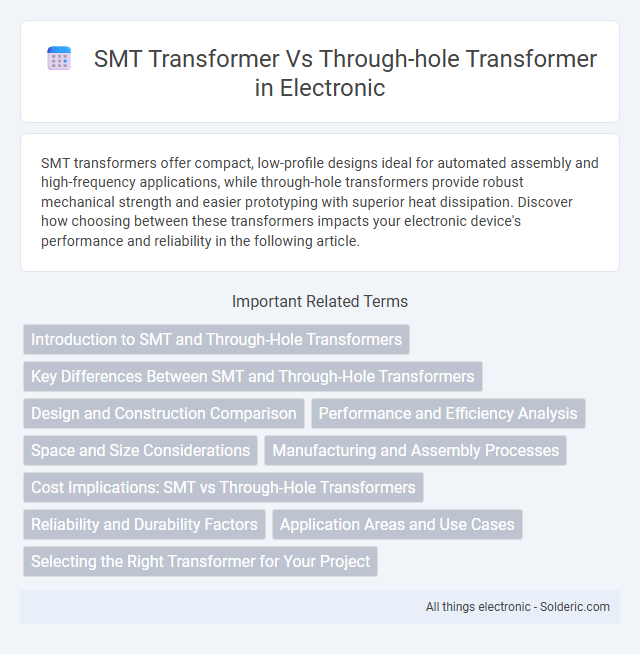SMT transformers offer compact, low-profile designs ideal for automated assembly and high-frequency applications, while through-hole transformers provide robust mechanical strength and easier prototyping with superior heat dissipation. Discover how choosing between these transformers impacts your electronic device's performance and reliability in the following article.
Comparison Table
| Feature | SMT Transformer | Through-Hole Transformer |
|---|---|---|
| Mounting Type | Surface-Mount Technology (SMT) | Leaded, inserted through PCB holes |
| Size | Compact, low profile | Larger, bulkier |
| Installation | Automated pick-and-place assembly | Manual or wave soldering |
| Electrical Performance | Optimized for high-frequency circuits | Suitable for higher power and low frequency |
| Mechanical Strength | Less robust, sensitive to mechanical stress | More durable, withstands vibration |
| Cost | Generally lower in mass production | Higher due to manual assembly |
| Applications | Portable electronics, compact devices | Power supplies, industrial equipment |
Introduction to SMT and Through-Hole Transformers
Surface-Mount Technology (SMT) transformers are designed for automated assembly on printed circuit boards (PCBs), featuring compact sizes and enhanced frequency performance, making them ideal for high-density electronic applications. Through-hole transformers, characterized by leads that pass through PCB holes, provide robust mechanical connections, suitable for high-power and high-reliability environments. SMT transformers support faster production and miniaturization, while through-hole transformers offer durability and ease of prototyping in complex circuit designs.
Key Differences Between SMT and Through-Hole Transformers
SMT transformers are designed for surface mounting on PCBs, offering compact size and automated assembly benefits, unlike through-hole transformers that require lead insertion through PCB holes, making them bulkier and suited for manual or wave soldering. SMT transformers typically allow for higher frequency operation and better mechanical performance due to shorter leads, whereas through-hole transformers excel in handling higher power with robust mounting. Your choice depends on application constraints like space, power requirements, and manufacturing processes.
Design and Construction Comparison
SMT transformers feature compact, surface-mount packaging ideal for automated PCB assembly, whereas through-hole transformers have larger leads designed for manual insertion into PCB holes. The construction of SMT transformers uses flat, low-profile cores and windings optimized for minimal height and space on densely populated boards. Through-hole transformers typically utilize bulkier bobbin-based windings and ferrite cores, offering enhanced mechanical strength but at the cost of greater board space and assembly complexity.
Performance and Efficiency Analysis
SMT transformers offer higher switching speeds and improved frequency response compared to through-hole transformers, resulting in enhanced signal integrity and reduced electromagnetic interference. Their compact design enables better thermal management and lower power losses, contributing to overall improved efficiency in power conversion applications. While through-hole transformers provide robustness in high-power scenarios, SMT transformers excel in precision electronics where performance and efficiency are critical.
Space and Size Considerations
SMT transformers offer a compact footprint and lower profile compared to through-hole transformers, making them ideal for high-density circuit boards where space optimization is critical. Their smaller size allows for more efficient use of PCB real estate, enabling miniaturization of electronic devices and improved thermal management. Choosing SMT transformers can enhance Your design by reducing assembly complexity and accommodating tighter spacing requirements in modern electronics.
Manufacturing and Assembly Processes
SMT transformers are designed for surface-mount technology, enabling automated pick-and-place assembly that significantly reduces manufacturing time and labor costs. Through-hole transformers require manual insertion and soldering of leads, resulting in longer assembly processes and increased potential for human error. The SMT approach supports higher component density and compatibility with automated assembly lines, enhancing production efficiency compared to through-hole transformers.
Cost Implications: SMT vs Through-Hole Transformers
SMT transformers typically offer lower manufacturing costs due to automated assembly and reduced labor requirements compared to through-hole transformers, which involve more manual soldering and time-consuming processes. The compact size of SMT transformers also leads to savings in PCB real estate and material usage, further reducing overall expenses. Your choice between SMT and through-hole transformers will impact procurement budget and production efficiency depending on volume and application complexity.
Reliability and Durability Factors
SMT transformers offer enhanced reliability due to their compact design and automated soldering process, reducing the risk of solder joint failures commonly seen in through-hole transformers. Through-hole transformers, although robust, face durability challenges from mechanical stress during vibration or thermal cycling, which can loosen leads or cause fractures over time. The inherent stability of SMT transformers on densely packed PCBs improves long-term durability in high-frequency and high-vibration environments.
Application Areas and Use Cases
SMT transformers are widely used in compact electronic devices such as smartphones, laptops, and IoT gadgets due to their small size and efficient surface-mount installation, making them ideal for high-density circuit boards. Through-hole transformers find applications in power supplies, audio equipment, and industrial machinery where higher power handling, mechanical strength, and thermal performance are crucial. The choice hinges on the application's space constraints, power requirements, and assembly methods.
Selecting the Right Transformer for Your Project
Choosing the right transformer depends on your project's size, mounting constraints, and electrical requirements; SMT transformers offer compact, surface-mount capabilities ideal for high-density circuit boards, while through-hole transformers provide robust mechanical strength for high-power applications. SMT transformers excel in automated assembly and reduced PCB space but may have lower power ratings compared to through-hole transformers, which are better suited for applications demanding higher voltages and currents. Evaluating factors such as thermal performance, power capacity, and available PCB area ensures optimal transformer selection aligned with project specifications.
SMT transformer vs through-hole transformer Infographic

 solderic.com
solderic.com